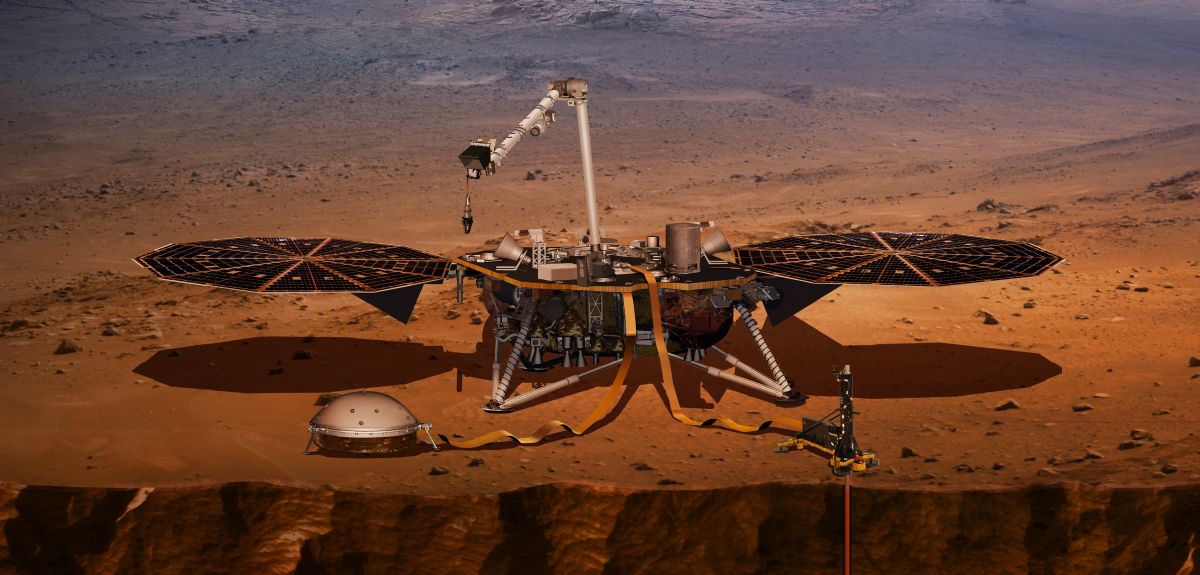
Measuring earthquakes on Mars
Oxford University is to contribute to a new mission to Mars, which will be the first to study the heart of the Red Planet and measure ‘Marsquakes’ from its surface.
The NASA InSight mission, which stands for Interior Exploration using Seismic Investigations, Geodesy and Heat Transport, is due to launch from California aboard a United Launch Alliance Atlas V rocket at 12.05pm (BST) today (Saturday 5 May).
The InSight Lander will use cutting-edge instruments to delve beneath the surface and investigate the interior of Mars to improve our understanding of how such planets formed. It will also study tectonic activity and meteorite impacts on Mars, both of which could provide valuable knowledge about these events on Earth.
Scientists from Oxford’s Department of Physics are working in collaboration with the UK Space Agency and Imperial College London to support one of the key instruments onboard: the short period Seismometer (SEIS-SP). This will be placed on the surface of Mars to detect seismic waves from Marsquakes and meteorite impacts.
Led by Professor Tom Pike from Imperial College London, Dr Simon Calcutt of Oxford’s Department of Atmospheric Physics, the Oxford team were responsible for assembling the spacecraft’s sensor chips and integrating them with their control electronics. This work involved packaging the sensor “chips” from Imperial College and then preparing and testing them so that they are fit for spaceflight.
Dr Neil Bowles, a member of the Oxford InSight team explains, ‘the InSight SEIS-SP seismometer is one of the most sensitive instruments we have worked on for spaceflight in Oxford. Ensuring that a traditionally delicate scientific instrument is capable of surviving launch on a rocket, cruise through interplanetary space and then landing on Mars has proved to be one of the most challenging missions that we worked on, and the Physics department has over 40 years of experience with sending things into space.
'With our partners at Imperial College, STFC RAL Space and the UKSA, getting it assembled, qualified and to the launch pad has been a significant effort and now we are in the anxious time waiting for launch and then landing in late November. After nearly a decade of preparation, building and testing we are excited that the science can then start.’
The team expect to detect anywhere between a dozen and a hundred of these tremors up to 6.0 on the Richter scale over the course of two years.
Prof Tom Pike said: ‘It’s been enormously challenging to put together such a small sensor with the performance we need to detect Marsquakes. We’ve had the support of the UK Space Agency, and their considerable patience. Now we finally get to see our microseismometers leave the launch pad, next stop Mars.’
The spacecraft is due to arrive on the surface of Mars on 26 November. The mission will conduct six science investigations on and below the surface of Mars to uncover the evolutionary history that shaped all of the rocky planets in the inner solar system.
Sam Gyimah, Science Minister, said: ‘The UK is playing an important role in this exciting mission to unlock the deepest secrets of our nearest neighbour in the solar system. An instrument that started life in a London university laboratory will end it on the surface of Mars detecting quakes and meteor strikes for the first time. ‘It's a great example of the importance of international collaboration and our work with the space sector as part of our Industrial Strategy, to ensure the UK remains at the forefront of pioneering science and exploration.’
 New study estimates NHS England spends 3% of its primary and secondary care budget on the health impacts of temperature
New study estimates NHS England spends 3% of its primary and secondary care budget on the health impacts of temperature
 International collaboration launches largest-ever therapeutics trial for patients hospitalised with dengue
International collaboration launches largest-ever therapeutics trial for patients hospitalised with dengue
 Oxford-built multi-agent assistant for cancer care to be piloted in collaboration with Microsoft
Oxford-built multi-agent assistant for cancer care to be piloted in collaboration with Microsoft
 World's first Phase II Nipah virus vaccine trial launch
World's first Phase II Nipah virus vaccine trial launch